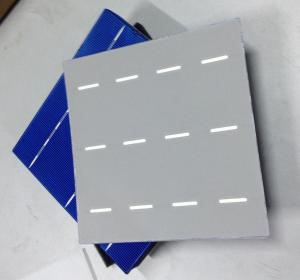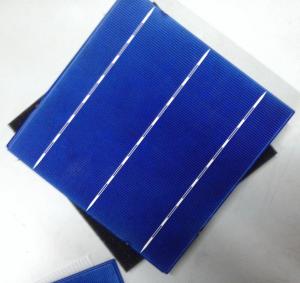Polycrystalline Silicon Solar Cell Type CSUN-M156-3BB-96
- Loading Port:
- China Main Port
- Payment Terms:
- TT or LC
- Min Order Qty:
- 5000 pc
- Supply Capability:
- -
OKorder Service Pledge
OKorder Financial Service
You Might Also Like
1. Structure of Polycrystalline Silicon Solar Cell Type CSUN-M156-3BB-96
A solar cell is an electrical device that converts the energy of light directly into electricity by the photovoltaic effect, which is a physical and chemical phenomenon. It is a form of photoelectric cell, defined as a device whose electrical characteristics, such as current, voltage, or resistance, vary when exposed to light. Solar cells are the building blocks of photovoltaic modules, otherwise known as solar panels. Solar cells are often electrically connected and encapsulated as a module. Photovoltaic modules often have a sheet of glass on the front (sun up) side, allowing light to pass while protecting the semiconductor wafers from abrasion and impact due to wind-driven debris, rain, hail, etc. Solar cells are also usually connected in series in modules, creating an additive voltage. Connecting cells in parallel will yield a higher current; our solar cells have passed IEC Certification. With high and stable quality, our cells can greatly improve the performance of Solar Modules.
2. Main Features of Polycrystalline Silicon Solar Cell Type CSUN-M156-3BB-96
1. Tire-1 Solar Cells’ Manufacturer Quality Guarantee. With a complete and sophisticated quality government system, our Quality Management have arrived world’s leading place. Customer can receive Tire-1 Cells Maker’s Quality Standard Products.
2. Trusted Warranty. We can supply trusted after-sales service to our customer. If our cells are found not in conformity to the specification of manufacturer, or should the inspected quantity found in shortage, or should the packing found damaged, the buyer has the right to claim to the seller. The claim, if any, should be presented to seller within 30 days after cargo's arrival date to the port, together with related inspection report and photos issued and provided by a reputable independent surveyor such as SGS.
3. World’s Leading Manufacturer Equipment. We imported the newest and leading production equipment from abroad. Advanced equipment can guarantee the stable quality of cells. Auto production line can also save labor cost which will further cut our production cost.
4. Bulk supply: With the production capacity of 500MW, we can produce large quantity every month. This can satisfy most customer requirement.
3. Polycrystalline Silicon Solar Cell Type CSUN-M156-3BB-96 Specifications
Format : 156 mm × 156 mm ± 0.5 mm
Thickness: 200 μm ±20 μm
Front (-) : 1.4mm bus bars (silver),blue anti-reflection coating (silicon nitride)
Back (+) : 1.8mm wide soldering pads (silver) back surface field (aluminium)
Efficiency (%) | Pmpp (W) | Umpp (V) | Impp (A) | Uoc (V) | Isc (A) | FF(1%) |
17.80-17.95 | 4.33 | 0.531 | 8.159 | 0.629 | 8.681 | 79.31 |
17.70-17.80 | 4.30 | 0.529 | 8.146 | 0.628 | 8.661 | 79.18 |
17.60-17.70 | 4.28 | 0.526 | 8.137 | 0.627 | 8.640 | 79.05 |
17.50-17.60 | 4.26 | 0.524 | 8.121 | 0.626 | 8.625 | 78.87 |
17.40-17.50 | 4.23 | 0.522 | 8.105 | 0.625 | 8.611 | 78.67 |
17.30-17.40 | 4.21 | 0.520 | 8.095 | 0.624 | 8.601 | 78.42 |
| 17.20-17.30 | 4.19 | 0.518 | 8.077 | 0.623 | 8.571 | 78.39 |
| 17.10-17.20 | 4.16 | 0.518 | 8.037 | 0.621 | 8.555 | 78.32 |
4. Polycrystalline Silicon Solar Cell Type CSUN-M156-3BB-96 Images
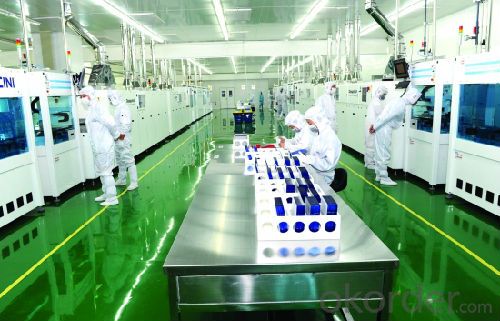
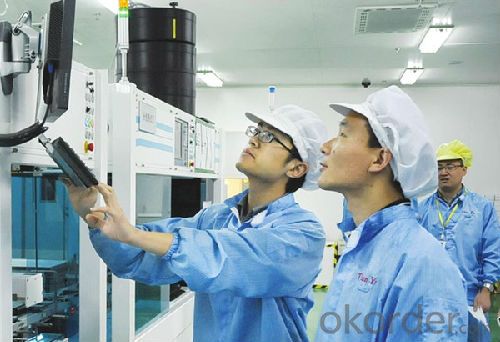
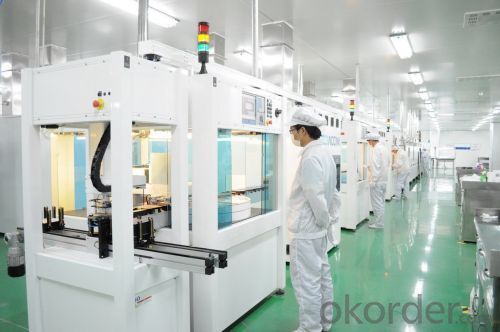
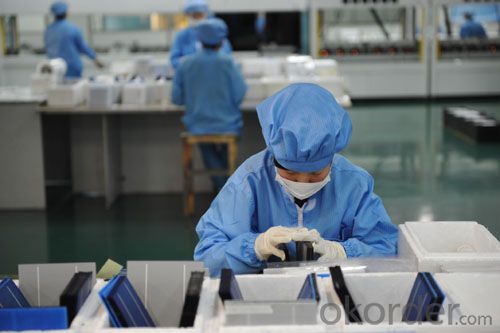
5. FAQ
Q1. How should you deliver the solar cells?
Re: We use carton box for packaging and deliver the solar cells by air in order to avoid the sunlight and moisture for the maximum degree.
Q2. How is your production and quality control?
Re: We use standard cells calibrated by Fraunhofer ISE and peel strength control.
- Q:Where can I help my company to buy the 3 Busbar Solar Cell for our project?
- I would like to know the details of the solar cells project you are working on and how many 3 busbar solar cells would you like to purchase.
- Q:How to get high voltage, high current output of solar cells
- A reasonable series of parallel can be, and increase the number of sub-batteries
- Q:How do solar cells perform in dry desert conditions?
- Solar cells perform exceptionally well in dry desert conditions. The intense sunlight and lack of moisture in deserts create ideal conditions for solar energy generation. The absence of clouds and high temperatures enhance the efficiency of solar cells, allowing them to produce more electricity. Additionally, the dry conditions minimize the risk of corrosion and dust accumulation, which can further improve the performance and lifespan of solar panels.
- Q:How do solar cells affect the environment?
- Solar cells have a positive impact on the environment. They produce clean, renewable energy by converting sunlight into electricity, reducing the reliance on fossil fuels. Solar cells emit no greenhouse gases or air pollutants during operation, helping to combat climate change and improve air quality. Additionally, they have a minimal impact on water resources and land use compared to other energy sources.
- Q:Is it possible to learn how to make solar cells by yourself?
- Are you good at doing experiments? If you are, try it as many times as you can, then you will be finally be an expert!
- Q:Can solar cells be used for powering electric water heaters?
- Yes, solar cells can be used to power electric water heaters. By converting sunlight into electricity, solar cells can provide a sustainable and renewable source of energy to heat water in electric water heaters. This helps reduce reliance on traditional grid electricity and lowers carbon emissions.
- Q:What is the window material in the solar cell? what's the effect?
- The meaning of the window layer with his Chinese meaning is the same, referring to the first solar cells to accept the light.
- Q:What is the average lifespan of a solar cell in space?
- The average lifespan of a solar cell in space can vary depending on various factors such as the quality of the materials used, the level of radiation exposure, and the overall design of the solar cell. However, on average, solar cells in space can last anywhere between 10 to 25 years.
- Q:Can solar cells be used to power remote weather stations?
- Yes, solar cells can be used to power remote weather stations. Solar cells convert sunlight into electricity, providing a reliable and sustainable power source for remote locations. This eliminates the need for traditional power grid connections and reduces operating costs. Additionally, solar cells can be easily installed and maintained in remote areas, making them an ideal solution for powering weather stations in such locations.
- Q:What is the payback period for installing solar cells?
- The payback period for installing solar cells varies depending on several factors such as the initial cost of the installation, the amount of energy generated, and the cost of electricity. On average, it typically takes between 5 to 10 years for solar cells to recoup their initial investment through energy savings.
1. Manufacturer Overview |
|
|---|---|
| Location | |
| Year Established | |
| Annual Output Value | |
| Main Markets | |
| Company Certifications | |
2. Manufacturer Certificates |
|
|---|---|
| a) Certification Name | |
| Range | |
| Reference | |
| Validity Period | |
3. Manufacturer Capability |
|
|---|---|
| a)Trade Capacity | |
| Nearest Port | |
| Export Percentage | |
| No.of Employees in Trade Department | |
| Language Spoken: | |
| b)Factory Information | |
| Factory Size: | |
| No. of Production Lines | |
| Contract Manufacturing | |
| Product Price Range | |
Send your message to us
Polycrystalline Silicon Solar Cell Type CSUN-M156-3BB-96
- Loading Port:
- China Main Port
- Payment Terms:
- TT or LC
- Min Order Qty:
- 5000 pc
- Supply Capability:
- -
OKorder Service Pledge
OKorder Financial Service
Similar products
New products
Hot products
Related keywords

